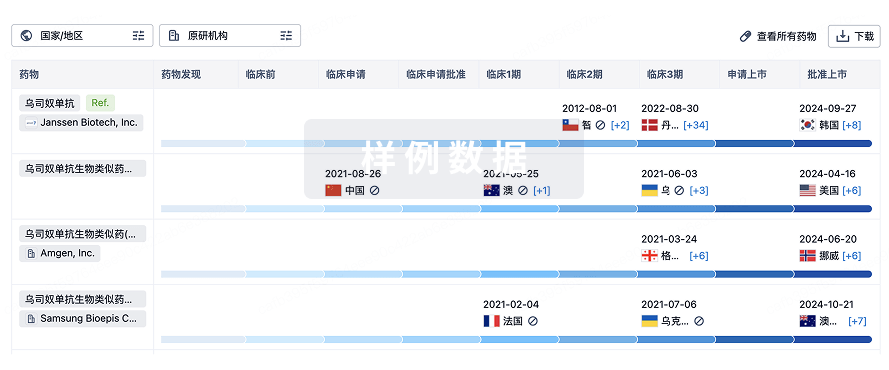预约演示
更新于:2025-10-11
JS-006
重组人源化抗TIGIT单克隆抗体(上海君实生物)
更新于:2025-10-11
概要
基本信息
原研机构 |
非在研机构- |
最高研发阶段临床1/2期 |
首次获批日期- |
最高研发阶段(中国)临床1期 |
特殊审评- |
登录后查看时间轴
关联
5
项与 重组人源化抗TIGIT单克隆抗体(上海君实生物) 相关的临床试验NCT05757492
A Phase 1, Multicenter, Open-label Study to Evaluate the Safety, Tolerability, Pharmacokinetics, and Preliminary Efficacy of CHS-006, as Monotherapy and in Combination With Toripalimab, in Participants With Advanced Solid Tumors
This phase 1 open-label study will evaluate the safety, tolerability, pharmacokinetics (PK), and preliminary efficacy of CHS-006 in combination with toripalimab in 2 phases. Phase 1 (Dose Optimization phase) will explore 2 different dose combinations in participants with advanced/metastatic solid tumors (except pancreatic) and Phase 2 (Indication-specific Expansion phase) will use one selected dose in specific tumor types (non-small cell lung cancer-non squamous [NSCLC-NS] and Hepatocellular carcinoma [HCC])
开始日期2023-04-26 |
申办/合作机构 |
NCT05650203
A Phase 1 Study to Evaluate the Safety, Tolerability, Pharmacokinetics and Preliminary Efficacy of JS009 Monotherapy and JS009 as a Triple Combination Therapy in Combination With Toripalimab and JS006 in Patients With Advanced Malignancies
The study is being conducted to evaluate the Safety, Tolerability, Pharmacokinetics and Preliminary Efficacy JS009 as a monotherapy and JS009 as a Triple Combination Therapy in Combination with Toripalimab and JS006 in Patients with Advanced Malignancies, also to explore the RP2D of JS009.
开始日期2023-03-31 |
申办/合作机构 |
NCT05253105
A Phase 1, Multicenter, Open-label Study to Evaluate the Safety, Tolerability, Pharmacokinetics and Preliminary Efficacy of TAB006, as Monotherapy and in Combination With Toripalimab, in Patients With Previously Treated, Advanced Malignancies
The primary objective is to assess the safety and tolerability of TAB006 as monotherapy and in combination with toripalimab in subjects with selected advanced solid malignancies, including lymphoma, and to evaluate the recommended Phase 2 dose.
The secondary objectives are to: 1) describe the pharmacokinetic (PK) profile of TAB006 monotherapy and in combination with toripalimab and to describe the PK profile of toripalimab when administered with TAB006, 2) evaluate antitumor activity of TAB006 monotherapy and in combination with toripalimab; and 3) determine the immunogenicity of TAB006 monotherapy and in combination with toripalimab and to determine the immunogenicity of toripalimab when administered with TAB006.
The secondary objectives are to: 1) describe the pharmacokinetic (PK) profile of TAB006 monotherapy and in combination with toripalimab and to describe the PK profile of toripalimab when administered with TAB006, 2) evaluate antitumor activity of TAB006 monotherapy and in combination with toripalimab; and 3) determine the immunogenicity of TAB006 monotherapy and in combination with toripalimab and to determine the immunogenicity of toripalimab when administered with TAB006.
开始日期2022-03-15 |
申办/合作机构  上海君实生物医药科技股份有限公司 上海君实生物医药科技股份有限公司 [+2] |
100 项与 重组人源化抗TIGIT单克隆抗体(上海君实生物) 相关的临床结果
登录后查看更多信息
100 项与 重组人源化抗TIGIT单克隆抗体(上海君实生物) 相关的转化医学
登录后查看更多信息
100 项与 重组人源化抗TIGIT单克隆抗体(上海君实生物) 相关的专利(医药)
登录后查看更多信息
1
项与 重组人源化抗TIGIT单克隆抗体(上海君实生物) 相关的文献(医药)2025-09-26·INVESTIGATIVE OPHTHALMOLOGY & VISUAL SCIENCE
Targeting Bcl3/NF-κB p50 Pathway for Neuroinflammation Attenuation and RGCs Protection in Retinal Ischemia/Reperfusion Injury
Article
作者: Chen, Jiachang ; Chen, Si ; Zeng, Zhou ; Quan, Chao ; Zhang, Xuan ; You, Mengling ; Fan, Cong ; Chen, Meini ; Xia, Xiaobo
Purpose:
Retinal ischemia/reperfusion (IR) injury caused by pathologically high intraocular pressure (ph-IOP) induces excessive inflammation, contributing to retinal ganglion cell (RGC) death in glaucoma. Lowering IOP alone is insufficient, highlighting the need for neuroprotective strategies. Resveratrol (RSV) exhibits anti-inflammatory and neuroprotective effects, but its molecular mechanisms remain unclear. This study aims to evaluate RSV's neuroprotective role and underlying mechanisms in retinal IR injury.
Methods:
Retinal morphology and RGC survival were assessed via immunofluorescence and hematoxylin and eosin (H&E) staining. Retinal function was evaluated using flash visual evoked potential (F-VEP) and flash electroretinogram (F-ERG). Inflammation and microglial activation were analyzed by quantitative real-time PCR (qRT-PCR) and immunohistochemistry. Pyroptosis and apoptosis were examined using Western blotting, TUNEL staining, and electron microscopy. RNA sequencing, qRT-PCR, and Western blotting identified molecular pathways.
Results:
RSV significantly protected RGCs and preserved retinal function. It reduced inflammation by inhibiting microglial activation and redistribution. Electron microscopy confirmed its protective effects against apoptosis and pyroptosis. Most importantly, we identified the Bcl3/NF-κB p50 pathway as a key target of RSV. Using the Bcl3-NF-κB p50-specific inhibitor JS-6, we validated this pathway's role in reducing neuroinflammation, pyroptosis, and apoptosis.
Conclusions:
This study provides insights into RSV's molecular mechanisms and identifies new therapeutic targets for glaucoma.
81
项与 重组人源化抗TIGIT单克隆抗体(上海君实生物) 相关的新闻(医药)2025-05-26
2015年9月,恒瑞医药以2500万美元首付款、总额7.7亿美元的价格将具有自主知识产权的PD-1单抗SHR-1210海外权益出售给美国Incyte公司,实现了中国药企第一次对外转让创新生物药,引起业内轰动。2025年5月,三生制药以12.5亿美元首付款、总额超60亿美元的价格将具有自主知识产权的PD-1/VEGF双抗SSGJ-707海外权益出售给美国辉瑞公司,创下中国创新药“出海”单笔交易首付款金额新纪录,再次引起业内轰动。十年间,中国创新药已实现了质的飞跃,从十年前单纯Fast follow欧美产品到现在更多聚焦于FIC及BIC产品,中国创新药的国际竞争力与日俱增。十年前,中国第一梯队PD-1单抗逐渐进入临床1期而浮出水面,分别来自恒瑞、君实、信达、百济,并在几年后率先获批在中国上市而被称为PD-1"四小龙"。正当PD-1"四小龙"在开展临床试验时,全球药企已将目光投向了下一代PD-1抗体的研发中,期望开发出一款能在临床上优于Keytruda/Opdivo的抗体并取而代之。PD-(L)1/VEGF双抗正是在这样的时代背景下立项开发的,而康方作为国内PD-1单抗第二梯队的领头羊是目前已知全球最早立项PD-(L)1/VEGF双抗(AK112)并将其推上临床并取得成功的(详见管中窥豹:康方生物的立项逻辑)。那么问题来了,占据先发优势的PD-1"四小龙"为什么没有开发PD-(L)1/VEGF双抗? 1、恒瑞 恒瑞在布局下一代PD-1抗体时,继续采用Fast follow的策略,在德国默克的PD-L1/TGFβ双抗(M7824)专利公开后不久就立项,利用其已开发了PD-L1单抗(SHR-1316)的优势,快速开发并推进同靶点双抗SHR-1701,并于2018年7月获批临床1期,成为全球第二款进入临床试验的同靶点药物。尽管在2021年1月,M7824在NSCLC临床3期与Keytruda头对头试验中失败而终止开发,恒瑞仍投入巨大资源继续SHR-1701的临床开发,同时开展了多种实体瘤的临床试验。2024年9月,恒瑞宣布SHR-1701的上市许可申请已经获国家药监局受理,用于局部晚期不可切除、复发或转移性胃及胃食管结合部腺癌的一线治疗。值得指出的是,SHR-1701并没有在临床上与Keytruda或其它PD-(L)1单抗进行头对头比较,而是采用了“SHR-1701+化疗”对照"安慰剂+化疗"的方案,因此其很难被称为是下一代PD-1抗体。 2、百济 百济在布局PD-1下一代抗体时,把目光聚焦在了TIGIT上。TIGIT是2009年由罗氏/基因泰克团队首先发现并持续研究最终于2016年5月将其单抗(Tiragolumab)推进至临床试验。这也引来了众多跟风者,而百济正是其中之一,其TIGIT单抗(Ociperlimab)于2020年进入临床并随后在2021年与其PD-1单抗(Tislelizumab)联用进行临床开发。彼时,整个肿瘤免疫领域都对TIGIT寄予厚望。2020年,在被问及对研发管线中的哪款产品最为期待时,百济创始人王晓东说,“从我个人来看应该是TIGIT抗体。”2021年,百济与诺华签署协议,双方将在北美、欧洲和日本共同开发、生产和商业化Ociperlimab,交易金额包括3亿美元的首付款和最高约26亿美元的里程碑付款。然而,随着2022年TIGIT领头羊罗氏/基因泰克在SCLC及NSCLC这两大适应症接连失利,TIGIT靶点的前景被蒙上阴影。此后不同公司的TIGIT单抗的更多临床失利更是让TIGIT逐渐成为历史(详见TIGIT的至暗时刻)。2023年7月,诺华宣布终止与百济关于Ociperlimab的合作开发。2025年4月,百济宣布终止Ociperlimab作为肺癌潜在治疗方法的临床开发项目。 3、信达 信达可以说是PD-1“四小龙”(甚至是所有中国药企)中围绕PD-1双抗做了最广泛布局的一个,据其公开进入临床阶段的PD-1双抗有PD-1/PD-L1(IBI-318)、PD-1/4-1BB(IBI-319)、PD-1/TIGIT(IBI-321)、PD-1/Her2(IBI-315)、PD-1/LAG3(IBI-323)、PD-1/CD47(IBI-322)、PD-1/IL-2(IBI-363)。而这些双抗除了PD-1/IL-2(IBI-363)以外,临床开发均已终止。2025年3月,信达宣布其全球首创PD-1/IL-2α-bias双抗(IBI-363),单药治疗黑色素瘤对比Keytruda的关键注册临床研究(NCT06797297)已完成首例受试者给药。在提前公布的2025年ASCO大会数据显示,在30例至少进行过 1 次基线后肿瘤评估的NSCLC鳞状细胞癌患者中,3 mg/kg IBI-363治疗组的ORR为43.3%,DCR为90%,中位PFS为7.3个月。IBI-363能否在临床上战胜Keytruda?目前仍需相当一段时间积累足够患者数据,但这也许是PD-1“四小龙”临床管线中唯一一款值得期待的潜在下一代PD-1抗体。 4、君实 与百济相似,君实也布局了TIGIT单抗(JS006)作为下一代PD-1抗体,并于2021年1月获批中国临床,进度略晚于百济的Ociperlimab。2022年1月,君实宣布与美国Coherus BioScience达成协议,后者以3500万美元首付款、总额2.9亿美元的价格获得JS006在美国及加拿大的权益。2024年1月,双方宣布终止该协议。其实,君实管线中有一款PD-1/VEGF双抗(JS207),于2023年9月进入临床1期并于近日进入联合化疗一线治疗晚期NSCLC的临床2期研究。从结构来看,JS207是君实基于其与多特生物(DotBio)的技术平台DotBody合作开发而得(图1)。图1. A:DotBody;B:JS207结构示意图但JS207的结构由于其两个Anti-PD-1 Fab与Fc形成的空间位阻,可能影响Anti-VEGF DotBody结合VEGF二聚体从而无法产生康方AK112所公布的MOA(Zhong T. et al., iScience 2025)(图2),因此需要进一步的机制研究。图2. AK112的MOA示意图目前全球有超30款PD-(L)1/VEGF双抗处于不同研发阶段,其中超75%来自中国,约30%处于临床2/3期(图3)。图3. 全球PD-(L)1/VEGF双抗竞争态势康方AK112以一己之力带火了这一赛道,不仅是第一款出海的PD-(L)1/VEGF双抗,也是第一款获批上市的PD-(L)1/VEGF双抗,更是第一款在临床上战胜Keytruda的抗体。中国创新药快速发展的这十年,业界已经充分意识到出海对于创新药发展的重要性。特别是对于下一代PD-1抗体这样的重磅炸弹级药物,出海并在欧美市场证明自己是必由之路。因此,笔者将截至目前已成功出海的PD-(L)1/VEGF双抗所在公司称为"五虎将",分别是康方、普米斯、宜明昂科、礼新、三生(图4)。图4. 五款出海PD-(L)1/VEGF双抗比较尽管PD-(L)1/VEGF"五虎将"在海外市场方面已具有先发优势,但仔细分析他们的合作方,仍存在较大差异。A. 辉瑞与默沙东作为顶级MNC在临床开发、注册申报、商业化等方面具有雄厚的实力及丰富的经验,将为PD-(L)1/VEGF双抗成为百亿美元超级重磅炸弹级药物奠定基础。此外,辉瑞与默沙东各自在ADC领域的深入布局也为PD-(L)1/VEGF双抗与不同ADC联合治疗提供了便利。B. Summit在引进AK112前是一家市值不到5亿美元的美国Biotech,但随着AK112在临床上的成功,其市值曾一度达到245亿美元,目前在192亿美元。由于Summit不具备商业化能力,且AK112是其唯一管线产品,因此一直在寻求与MNC的并购。但以其目前的市值,估计要等到AK112在OS上战胜Keytruda才会成交。C. BioNTech作为新冠疫苗“暴发户”在商业化方面与传统MNC仍有较大差距,当年其新冠疫苗就是由辉瑞负责临床开发、注册申报、生产和销售的。尽管BioNTech在后新冠时代加紧在全球布局相关能力,但能否独立支撑PM8002的商业化仍存在不确定因素。D. Instil Bio在2024年8月引进IMM2510时是一家市值不到1亿美元的Biotech,在2024年9月康方公布AK112在NSCLC的PFS优于Keytruda后,其市值曾一度超5亿美元,目前又回落到1.5亿美元以下。据说,Instil并没有在美国积极推进IMM2510的临床试验,因此其项目引进的投机目的较大,可能会寻求将IMM2510卖给有能力开发的药企以赚取差价。国内市场方面,除了AK112已获批上市以外,还有约8款PD-(L)1/VEGF双抗处于临床2/3期,相信未来将会有多款药物获批上市。但值得指出的是,即使上市,PD-(L)1/VEGF双抗也并不能很快取代PD-1单抗的市场。此外,PD-(L)1/VEGF双抗与ADC(或其它类型药物)联用也将在临床上进行验证,能否完胜PD-1单抗需要更多时间。至于那些尚未出海的PD-(L)1/VEGF双抗是否仍有机会?答案虽然是肯定的,但也不得不承认,大额交易的机会可能已经很少了。因为即使是欧美那么巨大的市场,目前也只有2款PD-1单抗(Keytruda; Opdivo)及2款PD-L1单抗(Tecentriq; Imfinzi)能达到年销售10亿美元以上。未来更多的机会可能是PD-(L)1/VEGF双抗与特定药物联用的合作交易。从PD-1"四小龙"到PD-(L)1/VEGF"五虎将",带来哪些启示?a. 创新药研发的核心是立项,一个正确的立项是项目成功的一半。对于PD-(L)1/VEGF双抗来说,PD-1"四小龙"完全有能力及资源研发,之所以没有研发或成功出海可能是错过了立项的时机。因此,未来各家药企研发能力的比拼可能是立项能力或者说是管线布局策略的比拼。b. 创新药的机会一直都在,并不会被MNC垄断,更不会被某些Biotech垄断。MNC最大的优势是资金雄厚,即使内部研发错过了机会,还可以通过引进或并购来弥补。Biotech最大的优势是研发效率高、项目推进快,重要的是利用有限的资源做正确的项目,如果能在临床上取得验证,一定会吸引MNC的兴趣。c. 随着中国创新药得到欧美药企的认可乃至在欧美市场占领一席之地,未来中国药企在BD交易中的谈判地位也将不断升高,从以前的买方市场变为卖方市场。d. 国内竞争环境激烈,任何同靶点的热门药物至少会有十几款甚至几十款药物处于不同研发阶段,但最后能成功出海的只是少数。对于PD-1单抗来说,各款药物之间的分子差异较小,能否出海研发速度是一个至关重要的因素。但是对于双抗来说,由于Format的不同、Fc工程改造差异、抗体亲和力(绝对值及相对值)的差异会造成分子差异较大,因此MNC在“扫货”时不仅会考虑研发速度,更会考虑分子设计、MOA差异化、临床前数据及临床设计差异化。这就是为什么默沙东在2024年11月选择了一款刚刚进入1期的PD-(L)1/VEGF双抗(LM-299),而不是当时几款已处于临床2期的双抗(详见通过比较4款出海PD-(L)1/VEGF双抗分析BioNTech/普米斯及默沙东/礼新交易背后的逻辑)。e. 创新药开发有点像中长跑,立项早也未必能先上临床,先上临床也未必能先获批上市,先获批上市也未必能卖得更好,有时候一直跟跑的选手最终却能在冲刺阶段反超。共建Biomedical创新生态圈!如何加入BiG会员?
临床3期引进/卖出申请上市临床1期临床2期
2025-05-09
·汇聚南药
2025年第一季度,国产创新药海外市场遭遇“黑天鹅”——超20笔涉及中国药企全球授权的交易,这其中就包括罗氏豪掷超10亿美元淘金信达生物,以及乐普生物就一款临床前ADC与ArriVent达成一笔超12亿美元的重磅合作。据动脉网不完全统计,截至2025年4月20日,在2020年已完成的62起license-out交易中,目前有25起已明确终止合作,“退货率”为40%,这不仅重创企业营收,更暴露了从临床试验设计到商业合作链条的系统性风险。这场危机背后,是临床试验数据不及预期、企业战略摇摆、买卖双方契约失衡等多重矛盾的集中爆发,而业务发展(BD)作为连接研发与市场的核心枢纽,首当其冲陷入困局。一、多临床试验不及预期,出海“地基”崩塌的连锁反应临床试验设计缺陷引发信任危机临床试验的“先天缺陷”首当其冲成为退货潮的导火索。许多药企为抢滩国际市场,在临床试验设计上走捷径:人种差异、年龄分层、地域性疾病谱等关键变量被忽视,导致疗效数据在真实世界中“失真”。一款针对中国患者设计的肺癌靶向药,因未纳入非洲市场的特定基因型患者数据,疗效波动引发大规模退货;某PD-1抑制剂过度依赖国内替代终点指标,却未能提供欧美监管机构要求的总生存期证据,最终被经销商以“证据不足”为由拒收。据动脉网消息,2022年7月,Elevation以近12亿美元总价从石药引进Claudin18.2 ADC项目EO-3021/SYSA1801,但不到三年后,其美国临床一期数据让Elevation深感失望,ORR仅为22.2%,与初期47.1%的数据差距较大,无法再向下推进。这些案例暴露出,以“中国数据闯全球”的粗放模式正在失效。药企必须从研发源头构建全球化证据链——通过国际多中心临床试验(MRCT)分层采集人种数据,利用区块链技术实现试验过程透明化,甚至与海外医生联合定义疗效终点。当临床试验从“单向输出”变为“多方共建”,证据链才能真正支撑市场信任。 二、战略调整:从“蒙眼狂奔”到“精准卡位”战略误判的代价“买方”自身战略的调整,这也会使国产创新药被迫出局。过去三年,国产创新药企以“广撒网”策略涌入30余个国家,却陷入“四处掘井,无水可饮”的困境:在东南亚因宗教禁忌触发退货,在欧洲因冷链物流不达标遭索赔,在非洲又因定价脱离本地支付能力导致库存积压。这种“重签约轻运营”的BD逻辑,本质是将海外市场视为短期套现的“货架”,而非需要培育的“土壤”。以Coherus为例,2024年1月其选择“退货”君实生物JS006,而这其中的导火索源于一次收购,2023年9月,Coherus收购了SurfaceOncology,在重新清点管线后,为将资源分配给管线中最有前途或最具竞争力的候选产品,Coherus认为,终止与君实生物在TIGIT项目上的合作符合利益最大化原则。事实上,在当前市场寒冬下,“买方”的战略调整只会更加直接和迅速。只有将市场选择与自身能力深度咬合,才能避免盲目扩张带来的系统性崩塌。三、退货潮溯源:BD战略的致命伤买卖双方契约的“权责错配”加剧了退货危机。传统BD合同中,药企往往将库存风险、物流成本、售后纠纷单方面转嫁给经销商,一旦遭遇市场波动,脆弱的合作纽带瞬间断裂。某东南亚经销商因汇率暴跌,联合渠道商以“包装瑕疵”为由集体退货;欧洲代理商因药企未及时提供不良反应数据,被迫承担巨额召回费用后愤而终止合作。这种“零和博弈”注定不可持续。因此,亟需重构契约精神,建立弹性分级退货机制——质量问题由药企全额承担,市场波动性退货双方按比例分摊;将首付款与研发里程碑绑定,让经销商从“风险承担者”变为“利益共同体”;甚至引入“医药跨境险”对冲突发风险。当合作框架从“博弈式条款”转向“共生型架构”,双方才能真正共享长期价值。 BD职能的进化则是破局的核心支点。过去,BD团队的角色更接近“交易撮合者”,考核指标聚焦签约数量和首付款金额。但在40%退货率的冲击下,这种模式已暴露致命短板:某双抗药物因临床试验数据遭质疑,授权金额从10亿美元缩水至3亿美元;跨国药企在合作中新增“数据复核期”,导致交割周期延长12个月。这意味着,BD必须从“销售前锋”蜕变为“生态建筑师”——在前端,BD需要介入临床试验设计,推动与目标市场的KOL联合制定研究方案;在中端,搭建动态定价模型,实时接入当地医保政策与竞品数据;在后端,与经销商共建数字库存系统,实现需求预测与柔性供应。更关键的是,BD团队需要从“能力拼图”升级为“人才共生体”:引入兼具临床医学与国际法务背景的复合型人才,在伊斯兰市场配备宗教合规官,在拉美设立本土化决策中心。唯有如此,才能将文化冲突、监管壁垒、市场误判等风险消化在合作网络内部。 四、“NewCo”模式脱颖而出据SRS ACQUIOM统计,2023年我国创新药里程碑达成率仅为22%,并且阶段越往后,达成率越低。 图1.生物制药领域2023年年中到期的各研发阶段里程碑事件达成情况(图源:研发客)究其原因,还是在于买卖双方风险承担的不对等,这场危机不仅是数字的警示,更是对传统模式的彻底拷问,于是,“NewCo”模式开始脱颖而出。据统计,2024年中国创新药企通过NewCo模式达成的交易金额已突破600亿元,较2023年增长54%。进入2025年,NewCo模式仍然保持高增长态势,光是在今年1月,就已经有5家公司通过NewCo模式成立。 图2.NewCo模式与License-out模式差异对比(动脉网制图)与传统的license-out相比,NewCo模式最为明显的差异就在于买卖双方更深度的绑定。因为它完全脱离主体,需要重新成立一家新的公司,并由买卖双方共同运营,这与license-out将所有决定权都交由MNC显然更加合理,其不仅可以规避风险,同时也可以将利益最大化和长期化。国内药企显然也意识到了这一点,以康诺亚为例,过去半年,其已经快速完成了3笔NewCo交易,潜在总金额11.4亿美元,占其总营收的比例高达95%。而能有如此表现,这与其战略选择不无关系:通过快速临床推进建立数据壁垒,以灵活授权交易获取生存资源,在风险可控的前提下探索国际化和平台化转型。结语:向“韧性出海”进化“被退货”其实是大概率事件,这与创新药“九死一生”的定律十分契合。对于国产创新药来说,想要成功出海,一定是需要新的东西来证明自己,比如领先全球的研发进度,或者对标全球更优的临床数据,再或者大幅领先的全球销售额等。40%的退货率是一记警钟,尤其是在“中美关税战”愈演愈烈的当下,海外交易的不确定性会更强,交易失败的概率也会更大,但这却恰恰也可能成为国产创新药战略进化的转折点。当药企不再将海外市场视为“清库存的货架”,而是“共同生长的土壤”,中国创新药才能真正在国际医药版图上扎根。注:本文部分内容摘自 动脉网 喜欢我们文章的朋友点个“在看”和“赞”吧,不然微信推送规则改变,有可能每天都会错过我们哦~免责声明“汇聚南药”公众号所转载文章来源于其他公众号平台,主要目的在于分享行业相关知识,传递当前最新资讯。图片、文章版权均属于原作者所有,如有侵权,请在留言栏及时告知,我们会在24小时内删除相关信息。信息来源:E药学苑往期推荐本平台不对转载文章的观点负责,文章所包含内容的准确性、可靠性或完整性提供任何明示暗示的保证。
抗体药物偶联物并购引进/卖出临床1期
2025-05-04
·赛柏蓝
编者按:本文来自动脉网,作者牟磊;赛柏蓝授权转载,编辑yuki01“退货率”40%?2024年,中国创新药BD交易市场格外火热。有研究报告显示,2024年我国药企共完成94笔license-out交易,总交易金额高达519亿美元,同比增长26%;其中首付款41亿美元,同比上涨16%。图1:2018-2024年中国药企licence-out交易数量及首付款(数据来源:医药魔方)进入2025年,这一势头仍在延续。据悉,刚刚过去的第一季度已出现超20笔涉中国药企全球授权的交易,包括罗氏豪掷超10亿美元淘金信达生物,乐普生物就一款临床前ADC与ArriVent达成一笔超12亿美元的重磅合作等。在专利悬崖压力下,海外大药企当前对中国创新药空前热情,并计划进一步“扫货”。这意味着,BD交易有望在今年再创新高。一片热闹之中,不少国内药企已经尝到了甜头。比如映恩生物成立仅六年,license-out已卖出超60亿美元,推动其在近期成功登陆港交所,并以113%的涨幅创下18A企业历史最高纪录;还有百利天恒,2024年实现扭亏为盈,净利大幅增长575%来到37.08亿元,这离不开一笔史诗级BD——2023年年底,BMS就BL-B01D1与百利天恒达成了总交易额84亿美元的天价协议,光首付款就高达8亿美元。但与此同时,BD失败的消息同时也在传来。据不完全统计,截至2025年4月20日,在2020年已完成的62起license-out交易中,目前有25起已明确终止合作,“退货率”为40%。2021年和2022年的“退货率”当前也达到20%左右,且有不少都是在今年宣布“分手”,比如诺诚健华的奥布替尼以及石药集团的ADC项目EO-3021等。经历过去两年疯狂的BD浪潮之后,国产创新药也来到了“清算”阶段。图2:2020-2024年中国药企licence-out“退货”率(截至2025.04)02“分手”,很难体面进入2025年,国产创新药在BD层面的纠纷就一直不断。2月,诺和诺德指控亨利医药涉嫌欺诈;3月,三叶草收到全球疫苗免疫联盟(GAVI)书面通知要求单方面终止预购协议并退还预付款;此外,石药与Elevation Oncology及诺诚健华与渤健等也都因为“分手”出现了摩擦。有资深投资人表示,“毕竟是几亿甚至是高达几十亿美元的合作,所以一旦出现问题,想要和平解决并非易事。”到底是因为什么让双方最终走到“分手”这一步?首先是后续临床数据欠佳。以最近终止合作的石药与Elevation为例,2022年7月,Elevation以近12亿美元总价从石药引进Claudin18.2 ADC项目EO-3021/SYSA1801,但不到三年后,其美国临床一期数据显示ORR仅22.2%,与初期47.1%的数据差距较大,无法再向下推进。图3:全球CLDN18.2 ADC研发管线(数据截至2024.05)其次是管线竞争格局千变万化。2024年8月,默沙东宣布退回科伦博泰SKB315的权益,虽然该靶点备受期待,但截至2024年4月,全球已有4款Claudin18.2 ADC进入临床Ⅲ期,目前还处于Ⅱ期的SKB315显然不具备优势。有资深投资人表示,“对于一些同质化竞争激烈、临床进度滞后的靶点,海外药企宁可放弃首付款,也会果断选择终止合作。”此外还有买方自身战略调整。以Coherus为例,2024年1月其选择“退货”君实生物JS006,而这其中的导火索源于一次收购,2023年9月,Coherus收购了SurfaceOncology,在重新清点管线后,为将资源分配给管线中最有前途或最具竞争力的候选产品,Coherus认为,终止与君实生物在TIGIT项目上的合作符合利益最大化原则。事实上,在当前市场寒冬下,买方战略调整只会更加直接、迅速。最后是政策层面变化。以首个闯关FDA的国产PD-1信迪利单抗为例,这原本是一笔跨时代的BD交易,但在2022年12月还是无奈按下了暂停键,礼来将权利退回给信达生物。这其中的关键因素在于FDA拒绝信迪利单抗治疗非鳞状非小细胞肺癌的在美上市申请,认为该申请仅基于在中国进行的Ⅲ期临床,不足以在美国获得批准。但舆论却站在了另一边,因为信迪利单抗在美国获批之后,将比现有的同类产品价格降低40%。除此之外,行业风口的转移以及同质化竞争引发的内卷旋涡等,也会促使BD合作的泡沫破裂。不难发现,虽然“退货”的理由各有不同,但其实都可以归纳为一个关键因素,即生存焦虑。03“退货”后失去的不仅仅是钱据SRS ACQUIOM统计,2023年我国创新药里程碑达成率仅为22%,并且阶段越往后,达成率越低。图4:生物制药领域2023年年中到期的各研发阶段里程碑事件达成情况(图源:研发客)也就是说,绝大多数国产创新药最后只能拿到首付款,而首付款恰恰是最低的一笔收入。我国创新药License out长期遵循“高总金额、低首付”的叙事逻辑,所以首付款往往只占到总交易额的2%~5%左右,以石药集团Claudin 18.2 ADC为例,其与Elevation的合作首付款仅2700万美元,后续的11.68亿美元里程碑付款需要跨越三期临床试验到商业化阶段才能获得。对此,某药企负责人谈道,“作为‘甲方’的MNC,始终掌控着交易的核心话语权。再加上国内药企都渴望与MNC合作来换取现金流,所以在交易的过程中更容易妥协,因而造成首付款金额普遍较低。但这对于MNC来说,则是利好,因为当项目推进受阻时,其只需要付出极小的代价。”对国内药企而言,合作终止后,突然停止的管线以及市场信心崩盘等,同样是亟待收拾的残局。2023年9月,I-Mab发布公告,全面终止与艾伯维就CD47单抗在研药物——来佐利单抗(lemzoparlimab)等产品的合作协议。作为一家尚未有产品实现商业化的创新药企业,I-Mab的现金流严重依赖BD收入,但随着艾伯维退出,其只有通过砍管线来勉强度日。到2024年7月,I-Mab创新管线仅剩3条;2025年1月,其又宣布暂停开发CD73单抗Uliledlimab(尤莱利单抗)。某资深投资人谈道,“对一家‘硬实力’还不够强的biotech来说,一款产品在需要大量烧钱的阶段时,合作被终止就等于提前‘死亡’。一是突然没了现金流来源;二是其市场信心会严重受挫,后续只有在临床试验中披露非常好的数据时,才能够再度找到‘买方’,但这种可能性微乎其微。”究其原因,还是在于买卖双方风险承担不对等,于是,“NewCo”模式开始脱颖而出。据统计,2024年中国创新药企通过NewCo模式达成的交易金额已突破600亿元,较2023年增长54%。进入2025年,NewCo模式仍然保持高增长态势,光是在今年1月,就已经有5家公司通过NewCo模式成立。 图5:NewCo模式与License-out模式差异对比与传统license-out相比,NewCo模式最明显的差异在于买卖双方更深度绑定。因为它完全脱离主体,需要重新成立一家新的公司,并由买卖双方共同运营,这与license-out将所有决定权都交由MNC相比显然更加合理,其不仅可以规避风险,同时也可以将利益最大化和长期化。国内药企显然也意识到了这一点,以康诺亚为例,过去半年,其已经快速完成了3笔NewCo交易,潜在总金额11.4亿美元,占其总营收的比例高达95%。而能有如此表现,这与其战略选择不无关系:通过快速临床推进建立数据壁垒,以灵活授权交易获取生存资源,在风险可控的前提下探索国际化和平台化转型。04保持理性切忌将BD当做“救命稻草”不少行业人士推测,经过这两年汹涌的海外BD浪潮之后,未来几年国产创新药“退货”事件会愈发增多。这并非危言耸听,在欧美成熟市场,创新药交易的变换更迭屡见不鲜。据Cotellis数据库,FDA批准的新药中,80%的新药都经过一次或一次以上的交易。这也就是说,“被退货”其实才是大概率事件,这与创新药“九死一生”的定律十分契合。有资深投资人认为,“BD本身就像在‘赌石’,尤其是当前越来越多的交易开始聚焦在早期甚至超早期管线,这一特性会体现地更为明显。毕竟早期分子面临的变数非常多,一旦有任何风吹草动都有可能立马终止,即便是像辉瑞这类头部MNC,其临床成功率也不到5%。”在一片热闹之中,国内企业更要理性看待BD的本质。图6:中国创新药融资总金额与License-out交易总金额对比(数据来源:医药魔方)一方面,在退出与生存压力并重的市场环境之下,BD的确可以解燃眉之急,甚至是帮助一部分国内药企逆天改命。华泰研究报告显示,2024年1-11月我国创新药BD的首付款高达62.73亿美元,比企业直接融资金额的39.77亿美元多出近一倍,BD显然已经成为国产创新药最重要的现金流来源。但另一方面,能够被BD并不意味着完美结局,因为其不仅要面临被抄底的境遇,同时还要承受与MNC交易带来的巨大对赌压力。事实上,在无比考验长期主义的创新药领域,比起license out刚开始市场反应的急不可待的欣喜,随后的困难与挑战反倒更值得警惕,尤其是在“关税战”愈演愈烈的当下,海外交易的不确定性会更强。BD应该是一种权衡利弊后的选择,而不是“病急乱投医”的尝试。下一步,国产创新药想要成功出海,一定需要新东西证明自己,比如领先全球的研发进度,或对标全球更优的临床数据,再或大幅领先的全球销售额等。这实际上就是创新药亘古不变的市场逻辑,即过硬的临床数据以及巨大的商业化前景。只有这样,即使面临“退货”,也有再度出售的机会和底气。END内容沟通:郑瑶(13810174402)
引进/卖出抗体药物偶联物疫苗并购
100 项与 重组人源化抗TIGIT单克隆抗体(上海君实生物) 相关的药物交易
登录后查看更多信息
研发状态
10 条进展最快的记录, 后查看更多信息
登录
| 适应症 | 最高研发状态 | 国家/地区 | 公司 | 日期 |
|---|---|---|---|---|
| 非小细胞肺癌 | 临床2期 | 中国 | 2023-12-12 | |
| 小细胞肺癌 | 临床2期 | - | 2023-07-04 | |
| 肝细胞癌 | 临床1期 | 美国 | 2023-04-26 | |
| 非鳞状非小细胞肺癌 | 临床1期 | 美国 | 2023-04-26 | |
| 晚期淋巴瘤 | 临床1期 | - | 2022-03-15 | |
| 晚期恶性实体瘤 | 临床1期 | - | 2022-03-15 | |
| 肝转移 | 临床1期 | - | 2022-03-15 | |
| 晚期癌症 | 临床1期 | 中国 | 2021-04-21 |
登录后查看更多信息
临床结果
临床结果
适应症
分期
评价
查看全部结果
| 研究 | 分期 | 人群特征 | 评价人数 | 分组 | 结果 | 评价 | 发布日期 |
|---|
No Data | |||||||
登录后查看更多信息
转化医学
使用我们的转化医学数据加速您的研究。
登录
或

药物交易
使用我们的药物交易数据加速您的研究。
登录
或

核心专利
使用我们的核心专利数据促进您的研究。
登录
或

临床分析
紧跟全球注册中心的最新临床试验。
登录
或

批准
利用最新的监管批准信息加速您的研究。
登录
或

生物类似药
生物类似药在不同国家/地区的竞争态势。请注意临床1/2期并入临床2期,临床2/3期并入临床3期
登录
或

特殊审评
只需点击几下即可了解关键药物信息。
登录
或

生物医药百科问答
全新生物医药AI Agent 覆盖科研全链路,让突破性发现快人一步
立即开始免费试用!
智慧芽新药情报库是智慧芽专为生命科学人士构建的基于AI的创新药情报平台,助您全方位提升您的研发与决策效率。
立即开始数据试用!
智慧芽新药库数据也通过智慧芽数据服务平台,以API或者数据包形式对外开放,助您更加充分利用智慧芽新药情报信息。
生物序列数据库
生物药研发创新
免费使用
化学结构数据库
小分子化药研发创新
免费使用
